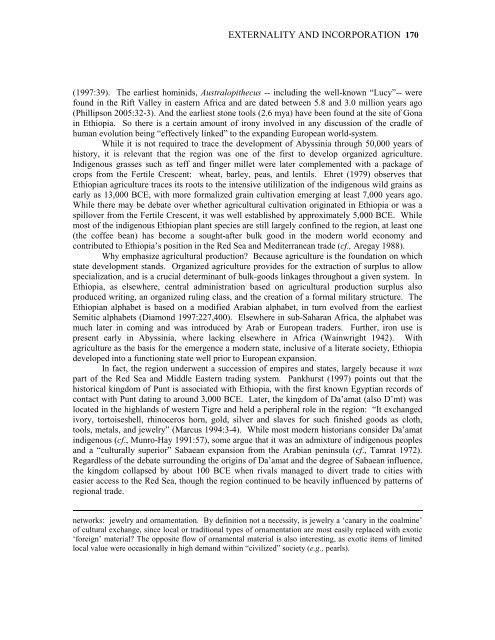Entire Volume 17 issue 1 - Journal of World-Systems Research ...
Entire Volume 17 issue 1 - Journal of World-Systems Research ...
Entire Volume 17 issue 1 - Journal of World-Systems Research ...
Create successful ePaper yourself
Turn your PDF publications into a flip-book with our unique Google optimized e-Paper software.
EXTERNALITY AND INCORPORATION <strong>17</strong>0<br />
(1997:39). The earliest hominids, Australopithecus -- including the well-known “Lucy”-- were<br />
found in the Rift Valley in eastern Africa and are dated between 5.8 and 3.0 million years ago<br />
(Phillipson 2005:32-3). And the earliest stone tools (2.6 mya) have been found at the site <strong>of</strong> Gona<br />
in Ethiopia. So there is a certain amount <strong>of</strong> irony involved in any discussion <strong>of</strong> the cradle <strong>of</strong><br />
human evolution being “effectively linked” to the expanding European world-system.<br />
While it is not required to trace the development <strong>of</strong> Abyssinia through 50,000 years <strong>of</strong><br />
history, it is relevant that the region was one <strong>of</strong> the first to develop organized agriculture.<br />
Indigenous grasses such as teff and finger millet were later complemented with a package <strong>of</strong><br />
crops from the Fertile Crescent: wheat, barley, peas, and lentils. Ehret (1979) observes that<br />
Ethiopian agriculture traces its roots to the intensive utililization <strong>of</strong> the indigenous wild grains as<br />
early as 13,000 BCE, with more formalized grain cultivation emerging at least 7,000 years ago.<br />
While there may be debate over whether agricultural cultivation originated in Ethiopia or was a<br />
spillover from the Fertile Crescent, it was well established by approximately 5,000 BCE. While<br />
most <strong>of</strong> the indigenous Ethiopian plant species are still largely confined to the region, at least one<br />
(the c<strong>of</strong>fee bean) has become a sought-after bulk good in the modern world economy and<br />
contributed to Ethiopia’s position in the Red Sea and Mediterranean trade (cf., Aregay 1988).<br />
Why emphasize agricultural production? Because agriculture is the foundation on which<br />
state development stands. Organized agriculture provides for the extraction <strong>of</strong> surplus to allow<br />
specialization, and is a crucial determinant <strong>of</strong> bulk-goods linkages throughout a given system. In<br />
Ethiopia, as elsewhere, central administration based on agricultural production surplus also<br />
produced writing, an organized ruling class, and the creation <strong>of</strong> a formal military structure. The<br />
Ethiopian alphabet is based on a modified Arabian alphabet, in turn evolved from the earliest<br />
Semitic alphabets (Diamond 1997:227,400). Elsewhere in sub-Saharan Africa, the alphabet was<br />
much later in coming and was introduced by Arab or European traders. Further, iron use is<br />
present early in Abyssinia, where lacking elsewhere in Africa (Wainwright 1942). With<br />
agriculture as the basis for the emergence a modern state, inclusive <strong>of</strong> a literate society, Ethiopia<br />
developed into a functioning state well prior to European expansion.<br />
In fact, the region underwent a succession <strong>of</strong> empires and states, largely because it was<br />
part <strong>of</strong> the Red Sea and Middle Eastern trading system. Pankhurst (1997) points out that the<br />
historical kingdom <strong>of</strong> Punt is associated with Ethiopia, with the first known Egyptian records <strong>of</strong><br />
contact with Punt dating to around 3,000 BCE. Later, the kingdom <strong>of</strong> Da’amat (also D’mt) was<br />
located in the highlands <strong>of</strong> western Tigre and held a peripheral role in the region: “It exchanged<br />
ivory, tortoiseshell, rhinoceros horn, gold, silver and slaves for such finished goods as cloth,<br />
tools, metals, and jewelry” (Marcus 1994:3-4). While most modern historians consider Da’amat<br />
indigenous (cf., Munro-Hay 1991:57), some argue that it was an admixture <strong>of</strong> indigenous peoples<br />
and a “culturally superior” Sabaean expansion from the Arabian peninsula (cf., Tamrat 1972).<br />
Regardless <strong>of</strong> the debate surrounding the origins <strong>of</strong> Da’amat and the degree <strong>of</strong> Sabaean influence,<br />
the kingdom collapsed by about 100 BCE when rivals managed to divert trade to cities with<br />
easier access to the Red Sea, though the region continued to be heavily influenced by patterns <strong>of</strong><br />
regional trade.<br />
networks: jewelry and ornamentation. By definition not a necessity, is jewelry a ‘canary in the coalmine’<br />
<strong>of</strong> cultural exchange, since local or traditional types <strong>of</strong> ornamentation are most easily replaced with exotic<br />
‘foreign’ material? The opposite flow <strong>of</strong> ornamental material is also interesting, as exotic items <strong>of</strong> limited<br />
local value were occasionally in high demand within “civilized” society (e.g., pearls).





